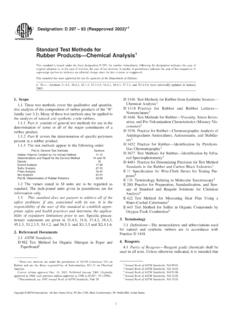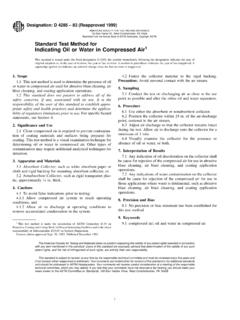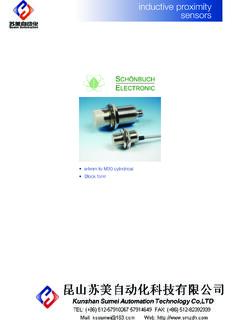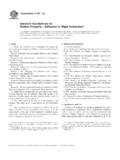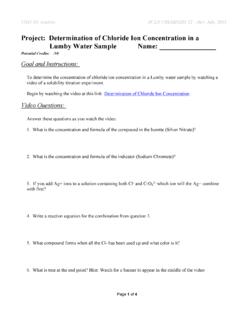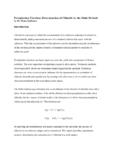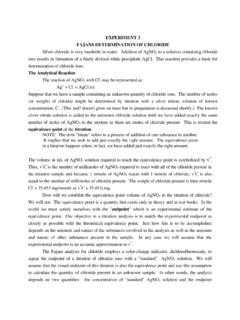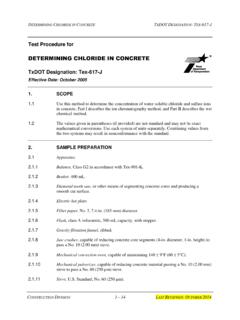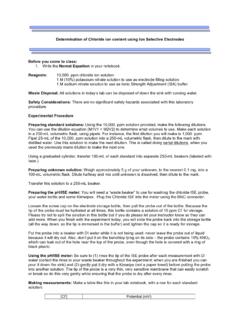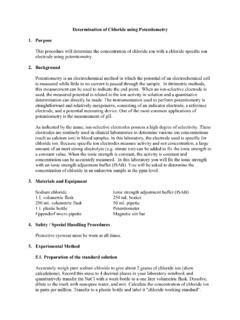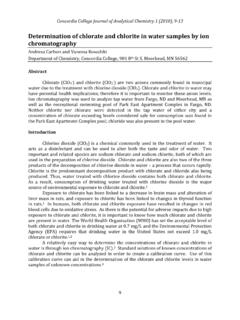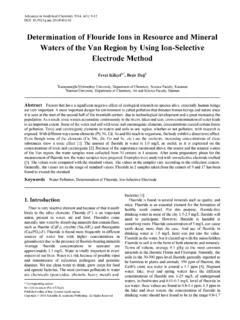Transcription of Standard Test Methods for Chloride Ion In Water
1 Designation: D 512 89 (Reapproved 1999)An American National StandardStandard Test Methods forChloride Ion In Water1 This Standard is issued under the fixed designation D 512; the number immediately following the designation indicates the year oforiginal adoption or, in the case of revision, the year of last revision. A number in parentheses indicates the year of last reapproval. Asuperscript epsilon (e) indicates an editorial change since the last revision or Standard has been approved for use by agencies of the Department of Scope* These test Methods cover the determination of chlorideion in Water , wastewater (Test Method C only), and brines. Thefollowing three test Methods are included:SectionsTest Method A (Mercurimetric Titration)7 to14 Test Method B (Silver Nitrate Titration)15 to 21 Test Method C (Ion-Selective Electrode Method)22 to Test Methods A, B, and C were validated under PracticeD2777 77, and only Test Method B conforms also to PracticeD 2777 86.
2 Refer to Sections 14, 21, and 29 for Standard does not purport to address all of thesafety concerns, if any, associated with its use. It is theresponsibility of the user of this Standard to establish appro-priate safety and health practices and determine the applica-bility of regulatory limitations prior to a specifichazard statement, see A former colorimetric test method was to Appendix X1 for historical Referenced standards :D 1066 Practice for Sampling Steam2D 1129 Terminology Relating to Water2D 1193 Specification for Reagent Water2D 2777 Practice for determination of Precision and Bias ofApplicable Methods of Committee D-19 on Water2D 3370 Practices for Sampling Water from Closed Con-duits2D 4127 Terminology Used with Ion-Selective Electrodes23.
3 For definitions of terms used in these testmethods, refer to Terminologies D 1129 and D Significance and Chloride ion is under regulation in Water , and must,therefore, be measured accurately. It is highly detrimental tohigh-pressure boiler systems and to stainless steel, so monitor-ing is essential for prevention of damage. Chloride analysis iswidely used as a tool for estimating the cycles of concentration,such as in cooling tower applications. Processing waters andpickling solutions used in the food processing industries alsorequire dependable Methods of analysis for Purity of Reagent grade chemicals shall be used in all otherwise indicated, it is intended that all reagents shallconform to the specifications of the Committee on AnalyticalReagents of the American Chemical Society, where suchspecifications are grades may be used, pro-vided it is first ascertained that the reagent is of sufficientlyhigh purity to permit its use without lessening the accuracy ofthe of Water Unless otherwise indicated.
4 All refer-ences to Water shall be understood to mean Type II reagentwater conforming to Specification D Collect the sample in accordance with Practice D 1066and Practices D 3370, as METHOD A MERCURIMETRICTITRATION47. This test method can be used to determine Chloride ionin Water , provided interferences are absent (see Section 9).1 These test Methods are under the jurisdiction of ASTM Committee D-19 onWater and are the direct responsibility of Subcommittee on InorganicConstituents in edition approved Oct. 2, 1989. Published December 1989. Originallypublished as D 512 38. Last previous edition D 512 Book of ASTM standards , Vol Chemicals, American Chemical Society Specifications,AmericanChemical Society, Washington, DC.
5 For suggestions on the testing of reagents notlisted by the American Chemical Society, seeAnalar standards for LaboratoryChemicals,BDH Ltd., Poole, Dorset, , and theUnited States Pharmacopeiaand National Formulary, Pharmaceutical Convention, Inc. (USPC), Rockville, information of interest in connection with this test method, and supportingdata, refer to Clark, F. E., determination of Chloride in Water , AnalyticalChemistry, Vol 22, April 1950, pp. 553 555, and Vol 22, November 1950, p. *A Summary of Changes section appears at the end of this ASTM International, 100 Barr Harbor Drive, PO Box C700, West Conshohocken, PA 19428-2959, United Though not specified in the research report, the preci-sion statement is presumed to have been obtained using Type IIreagent Water .
6 It is the responsibility of the analyst to assure thevalidity of this test method for untested This test method was validated for the concentrationrange to 250 mg/L Cl .8. Summary of Test Dilute mercuric nitrate solution is added to an acidifiedsample in the presence of mixed diphenylcarbazone-bromophenol blue indicator. The end point of the titration is theformation of the blue-violet mercury diphenylcarbazone The anions and cations generally found in Water offer nointerference. Zinc, lead, nickel, and ferrous and chromous ionsaffect solution and end-point colors, but do not reduce theaccuracy of the titration when present in concentrations up to100 mg/L. Copper is tolerable up to 50 mg/L. Titration in thepresence of chromate ion requires indicator with extra back-ground color (alphazurine) and prior reduction for concentra-tions above 100 mg/L.
7 Ferric ion above 10 mg/L must bereduced before titration, and sulfite ion must be and fluoride will be partially titrated with the chlo-ride. Quaternary ammonium salts also interfere if present insignificant amounts (1 to 2 mg/L). Deep color may , 1 or 5-mL, with Reagents and Peroxide(30 % H2O2). Solution(10 g/L) Dissolve1gofpurified hydroquinone in Water and dilute to 100 Nitrate Solution, Standard ( ) Dissolve g of mercuric nitrate (Hg(NO3)2 H2O) in 50mL of Water acidified with mL of concentrated nitric acid(HNO3, sp gr ). Dilute the acidified Hg(NO3)2solutionwith Water to 1 L. Filter if necessary, and standardize againstthe Standard sodium Chloride (NaCl) solution, using the pro-cedure described in Section 12 (see Note 1).
8 NOTE1 Sharpness of End Point The end point, while sharp, can beimproved somewhat for certain types of Water by adding several drops ofa solution of xylene cyanole FF or alphazurine blue-green dye(color index 714) to the titration Indicator Solution5 Dissolve g of crystal-line diphenylcarbazone and g of bromophenol bluepowder in 75 mL of ethyl alcohol (95 %), and dilute to 100 mLwith the alcohol (Note 2). Store in a brown bottle and discardafter 6 months (Note 3).NOTE2 Methanol, isopropanol, or ethanol denatured with eithermethanol or isopropanol (Formula 3A) may be used if pure ethyl alcoholis not available. Other denatured ethanol formulae are not Liquid indicator generally deteriorates to the point that ityields no end-point color after 12 to 18 months of storage.
9 Hightemperature (above C (100 F)) and exposure to bright light mayshorten storage life. A dry powder mixture of the two indicator ingredientsis stable for much longer periods. Both the powder mixture (capsule form)and the liquid indicator are available Acid(3 + 997) Mix 3 volumes of concen-trated nitric acid (HNO3, sp gr ) with 997 volumes Indicating Paper, long-range type, covering a pHrange 1 to Chloride Solution, Standard ( ) Dryseveral grams of sodium Chloride (NaCl) for1hat600 g of the dry salt in Water , and dilute to 1 L at25 C in a volumetric Hydroxide Solution(10 g/L) Dissolve 10 g ofsodium hydroxide (NaOH) in Water and dilute to 1 Use a volume of sample such that it will contain notmore than 20 mg of Chloride ion, diluting the sample withwater to approximately 50-mL volume if necessary.
10 Determinean indicator blank on 50 mL of Chloride -free Water , applyingthe same procedure followed for the Add 5 to 10 drops of mixed indicator solution, andshake or swirl the flask. If a blue-violet or red color develops,add HNO3(3 + 997) dropwise until the color changes toyellow. Add 1 mL of excess acid. If a yellow or orange colorforms immediately on addition of the mixed indicator, addNaOH solution (10 g/L) dropwise until the color changes toblue-violet; then add HNO3(3 + 997) dropwise until the colorchanges to yellow and further add 1 mL excess of acid (Note4).NOTE4 The prescribed acidification provides a satisfactory pH rangefrom to Acidified samples on which electrometric pH measure-ments have been made shall not be used for Chloride determinations,because the use of the calomel reference electrode may introduce error dueto Chloride contamination.




